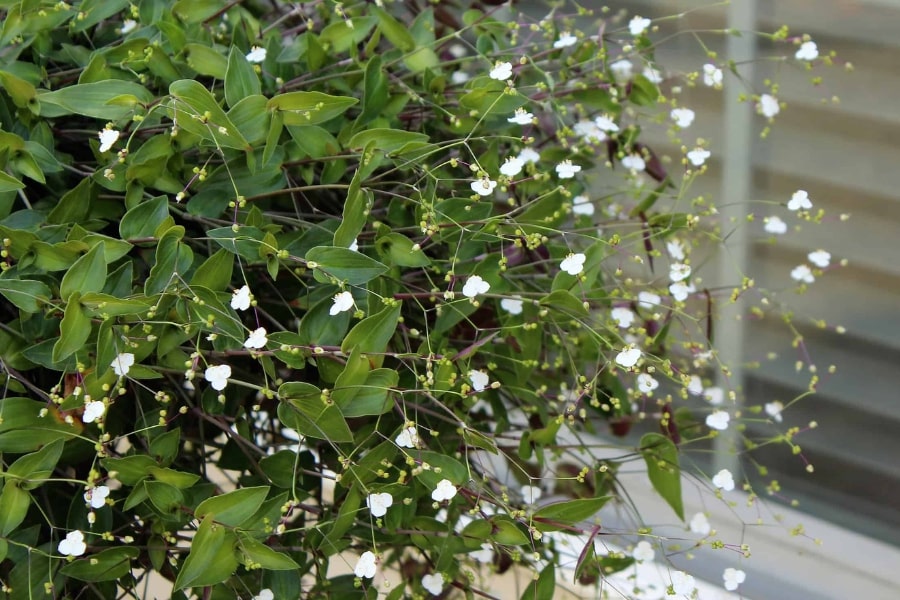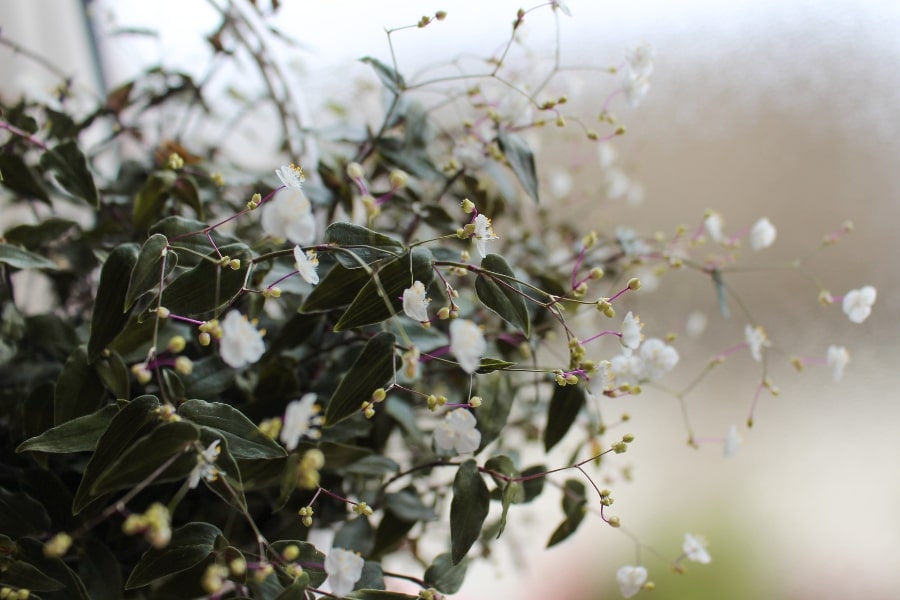The Bridal Veil plant, scientifically known as Gibasis geniculata, is a charming trailing vine native to Mexico and Central America. Also commonly referred to as “Tahitian Bridal Veil” or “Tahitian Bridal Wreath,” this delicate plant is prized for its graceful cascading foliage and dainty white flowers.
With its airy appearance reminiscent of a bridal veil gently flowing in the breeze, the Bridal Veil plant adds an elegant touch to gardens, hanging baskets, and indoor spaces. The Bridal Veil is a small, trailing vine that typically reaches a height of 6 to 12 inches (15 to 30 cm) and spreads up to 3 feet (90 cm) or more.

Our Selection of Bridal Veil
At Martin Garden Center, we grow and often have available 4″ containers of Bridal Veil. We also prepare 10″ hanging baskets of Bridal Veil for the Spring season. We usually sell 20-30 hanging baskets in the spring, and we try to keep Bridal Veil in hanging baskets stocked all year round. We only offer 4″ in the spring, though sporadically.
Growing and Caring For Bridal Veil
- Light and Location: Bridal Veil plants thrive in bright, indirect light, making them ideal candidates for indoor spaces near windows or under skylights. They prefer partial shade to full shade, as direct sunlight can scorch their delicate foliage. Choose a location with dappled sunlight or filtered shade, such as beneath trees or on a shaded patio, to provide optimal light conditions for healthy growth.
- Soil and Watering: Provide Bridal Veil plants with well-draining soil that retains moisture without becoming waterlogged. A high-quality potting mix formulated for indoor plants or a loamy garden soil with added organic matter works well. Water the plants regularly, keeping the soil evenly moist but not waterlogged. Allow the top inch of soil to dry out slightly between waterings to prevent overwatering, which can lead to root rot.
- Humidity and Temperature: Bridal Veil plants prefer warm, humid conditions similar to their native habitat in tropical regions. Indoor plants benefit from regular misting to increase humidity levels around the foliage. Alternatively, place a humidity tray filled with water and pebbles beneath the pot to create a humid microclimate. Keep indoor temperatures between 60°F to 75°F (15°C to 24°C), avoiding drafts and sudden temperature fluctuations.
- Pruning and Maintenance: To maintain a neat and compact appearance, occasionally prune Bridal Veil plants to remove leggy or straggling stems. Pinch back the growing tips to encourage bushier growth and stimulate new foliage production. Remove any dead or yellowing leaves promptly to prevent the spread of disease and maintain the plant’s overall health and appearance.
- Propagation and Repotting: Bridal Veil plants can be easily propagated from stem cuttings, making them an excellent choice for gardeners looking to expand their plant collection. Simply snip a healthy stem with a sharp, clean pair of scissors or pruning shears, remove the lower leaves, and place the cutting in a container filled with moist potting mix. Keep the cutting in a warm, humid environment until roots develop, then transplant it into its pot. Report Bridal Veil plants as needed to provide ample space for root growth and refresh the soil with fresh nutrients.
Leaves and Flowers
The foliage of the Bridal Veil plant is its defining feature, with slender, lance-shaped leaves that create a soft, airy texture. The leaves are typically light green and may feature subtle variegation along the margins, adding visual interest to the plant. As the stems trail and cascade, the foliage forms a dense, cascading canopy that lends a sense of elegance to any space.
In addition to its graceful foliage, the Bridal Veil plant produces delicate white flowers that bloom sporadically throughout the growing season. These tiny, star-shaped flowers are borne on slender stems and add a charming accent to the trailing foliage. While the individual flowers are small, their sheer abundance creates a stunning display that enhances the plant’s overall beauty.

Uses in the Garden
Bridal Veil plants are incredibly versatile and can be used in a variety of ways to enhance garden spaces. Their trailing habit makes them ideal for hanging baskets, where they can cascade gracefully over the edges, creating a cascading waterfall of foliage and flowers. Bridal Veil plants can be used in garden beds and borders as ground covers or edging plants, providing a soft, delicate backdrop for taller perennials and shrubs.
These charming plants also make excellent additions to container gardens, where they can be showcased on patios, balconies, or indoor spaces. Pair Bridal Veil plants with complementary foliage plants or colorful flowering annuals to create stunning mixed containers that brighten up any outdoor or indoor setting.
Frequently Asked Questions
Can I Grow Bridal Veil Plants Indoors?
Yes, Bridal Veil plants can be grown indoors in bright, indirect light. Provide adequate humidity by misting the foliage regularly or placing a humidity tray filled with water and pebbles beneath the pot.
How Often Should I Water My Bridal Veil Plant?
Water Bridal Veil plants regularly, keeping the soil evenly moist but not waterlogged. Allow the top inch of soil to dry out slightly between waterings to prevent overwatering.
Is The Bridal Veil Plant Tolerant Of Cold Temperatures?
Bridal Veil plants are not cold-hardy and should be protected from frost and freezing temperatures. If grown outdoors in cooler climates, bring them indoors before the first frost or treat them as annuals.
